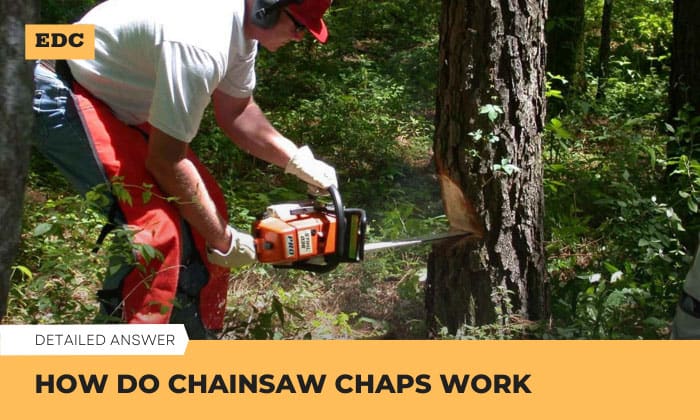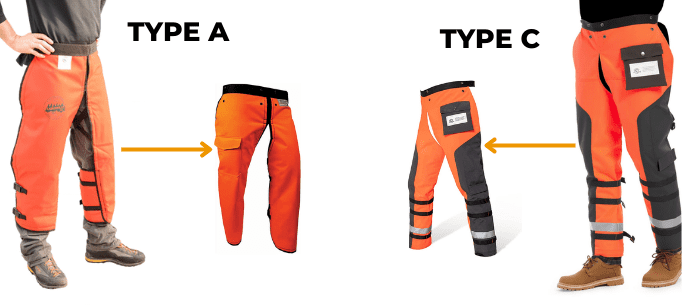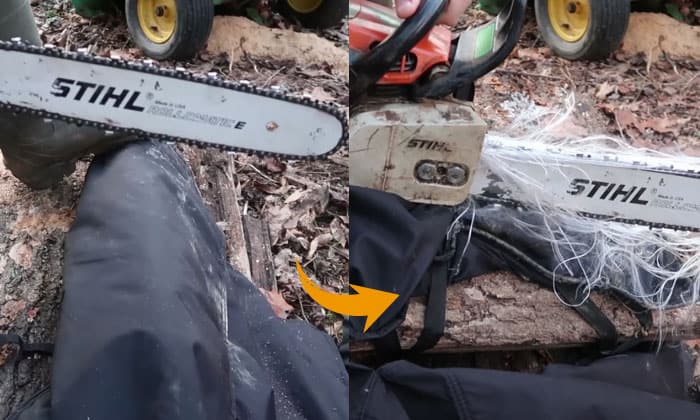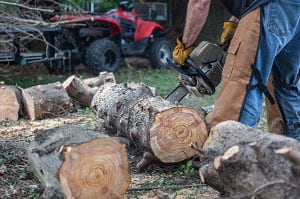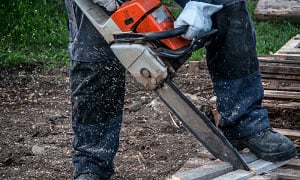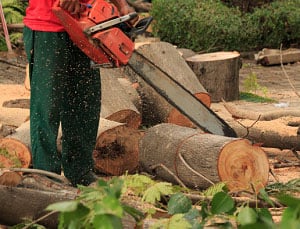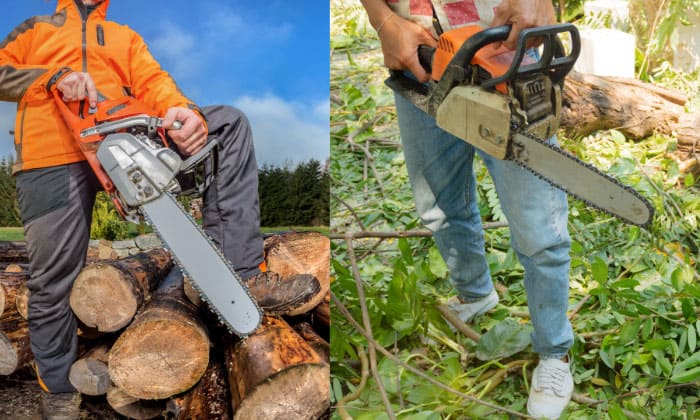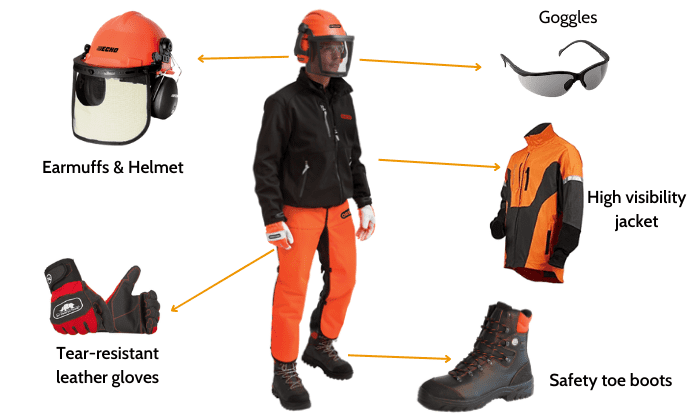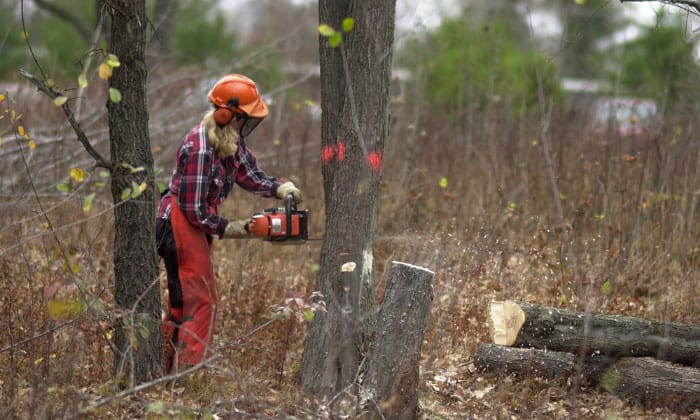While it only takes a couple of minutes to cut a thick wooden block using a chainsaw, this tool can also cause serious injuries if you’re not careful. For this reason, OSHA requires workers to wear chainsaw chaps made from cut-resistant materials to protect their legs.
But how do chainsaw chaps work exactly? What are they made of?
Table of Contents
Overview of Chainsaw Chaps
There are two types of chainsaw leg protection: Type A, which covers only the front side of the legs, and Type C, which offers 360-degree protection.
- Most apron-style chainsaw-cutting chaps fall under Type A, which are conventionally worn over a pair of trousers. Those that come in the form of pants also only provide front-leg protection.
- Meanwhile, Type C is typically in the form of trousers. You don’t need to wear anything under or over the safety pants for chainsaws.
Another key difference between type A and C is the former is usually for ground workers, whereas the latter is more suitable for those who have to work at weird angles.
How Does It Work?
A pair of chainsaw trousers or chaps for chainsaw work features several layers of fabrics and fibers.
The outermost layer is composed of slick hard-wearing cut-resistant fabric. Underneath this are multiple layers of fibers like Avertic, Kevlar, ballistic nylon, or polyester.
When the chainsaw cuts through the outer fabric, it stops penetrating further into the chap as the fibers get entangled by it. Even so, don’t be too optimistic and assume that your legs will be completely spared from injuries.
To be clear, chaps are not formidable barriers against the blades of your chainsaw. Realistically speaking, these devices can only mitigate injuries.
Pros of Wearing Chaps
- Since the backside of the chaps is open, the ir can circulate and keep the wearer cool under hot conditions. Workers can even remove them when taking a break.
- Chaps are low maintenance. You only need to scrub your chaps once in a while, put them in their proper storage, and inspect them for any signs of damage before each use.
- Since chaps are not in direct contact with the skin, it’s okay to share a couple of pairs of chaps among several workers.
Cons of Wearing Chaps
- Forester chainsaw chaps offer ample protection against lacerations. However, they are not suitable for environments where snagging hazards can occur.
If you are holding a chainsaw, you might lose your balance and get injured when a branch of a felled tree gets caught by the chaps.
- Chaps are typically sold in fewer sizing options. One such example is the Stihl chainsaw chaps, which offer size 32, 36, and 40. Even with adjustable straps, you cannot expect that every body type will fit perfectly in chaps.
Some workers will have to put up with the poor-fitting ones that often hinder mobility, which can be a workplace hazard in and of itself.
Can I Use Chaps After They’ve Been Cut?
No, if the chainsaw has cut into the chaps, you’ll have to retire them, as they no longer offer proper protection.
In addition, you need to remove your leg protection in service if you see the following during the inspection:
- A 1-inch cut or longer on the first layer of fibers (e.g., Kevlar)
- Nicks and holes on the outer layer
- Damages due to poor storage or harsh cleaning products
- Accumulation of dirt and grease that are impossible to remove by washing
- Saw dust or pieces of wood penetrating inner layers of fiber filling
- Alterations or repairs
Regardless of the brand and model, chainsaw chaps become less effective in providing protection when they are damaged, muddied, or tampered with in attempts to repair.
Can I Use a Chainsaw After It’s Been Jammed by Chaps?
Yes. All you need to do is remove the chaps’ filling that got caught in the saw. First, take out the fibers around the sprocket, then work your way toward the bar and the rest out of the chainsaw. Ensure that each and every part is cleaned before assembling them back.
Things to Consider Before Buying Chainsaw Chaps
When you’re choosing a specific model to buy, it’s not enough to know the answer to, “What do chaps do?”
1. Class
“Class” refers to the amount of protection that the chaps or trousers can provide in relation to the speed of the chainsaw. Note that the speed below is measured in meters per second (m/s):
- Class 0: up to 16 m/s
- Class 1: up to 20 m/s
- Class 2: up to 24 m/s
- Class 3: up to 28 m/s
If you don’t know the speed of your chainsaw, check its user manual. Next, look for the woodcutting chaps with a class rating that matches your chainsaw’s speed.
For instance, your chainsaw can go up to 24 m/s—the obvious choice would be Class 2. That said, why can’t we just wear Class 3 to protect ourselves against any kind of chainsaw?
Well, it’s not a good idea considering that the higher class ratings have thicker fabrics. Under hot conditions, this can feel uncomfortable and may even lead to heat strokes!
2. Fit and comfort
By design, chaps are supposed to be bigger than your pants to ensure that it fits comfortably and allow you to move freely.
Choose chainsaw chaps that suit your body type by measuring the length between your waist and the instep of your foot, which is located right above your arch.
3. Affordability
When buying chainsaw chaps, it’s better to opt for more expensive options that come with more layers for better protection. After all, their price isn’t that high, as most only cost around $50-$100 apiece.
4. Compliance with safety regulations
So you found the right size and class. Now you need to check whether the ballistic nylon or Kevlar chain saw chaps meet the safety requirements in your region. Here’s what you need to take note of:
Leg protection devices sold in the US are certified by the UL, ensuring that they meet the ASTM F1897-14, ANSI, and OSHA. Its European counterpart follows EN ISO 11393.
Chaps vs. Pants
- Safety – Earlier, we already alluded to the fact that chaps can get snagged by protruding objects like tree branches or other equipment that you may have in your workplace. Under such circumstances, the best solution is to wear chainsaw-proof pants.
- Fitting – Compared to chaps, pants fit better as they are available in various sizes for women and men, enabling the wearer to move with ease.
- Comfort – Chaps tend to be more breathable, especially when worn with lightweight pants. By contrast, Kevlar pants chainsaw protection can feel extremely toasty during summer.
The good news is that some manufacturers are now developing lightweight fabrics. But unlike the chaps, you are stuck in your pants until the end of your shift.
- Maintenance – Chaps are a lot easier to maintain. Granted, manufacturers recommend both hand-washing and machine-washing to clean chainsaw pants. But let’s be real here—no one has time to hand-wash after toiling away in the forest, even if it’s the least damaging method.
If you sweat in pants daily, you would use the washer more than once a week, and this can contribute to their faster deterioration.
Which one is more affordable?
Chaps are cheaper than chainsaw pants. Take the Echo chainsaw chaps, for example, which costs $99. The same brand sells its trousers at $135.
Paying a couple of dollars more is not a big deal if you are buying for yourself, but employers would think twice about it.
Apart from that, employees need more than just one pair if they use the pants daily. Besides that, they cannot share their sweaty chainsaw pants with other workers!
Safety Gear You Can Use
Besides the woodcutting chaps or trousers, you need to wear the following:
- ANSI Z87.1 goggles
- 25 dB NRR earmuffs
- ANSI Z89.1 helmet
- High visibility jacket
- Tear-resistant leather gloves
- Safety toe boots
Frequently Asked Questions
What is the importance of chainsaw chaps?
In the US, the CDC reports roughly 36,000 people are hospitalized each year due to chainsaw-related injuries. This alone should give you a reason to wear leg protection.
And as pointed out above, although chaps may not prevent chainsaw-related injuries entirely, they can drastically lessen the severity of the wound.
How many layers do you need for chainsaw chaps?
Cheap chainsaw chaps feature four layers of protective fibers inside a pair of chainsaw chaps. This can be sufficient, but it’s better to have eight to nine layers of fibers, six layers of protective fabric, and two layers of padding.
How long should the chainsaw be?
It depends on how small or big the tree you want to cut. Small to medium trees will require a 16-inch chainsaw, whereas felling large trees will call for a chainsaw with at least 20-inch lengths. As for pruning small tree branches, 14-inch chainsaws or smaller ones will suffice.
Note that electric chainsaws are mostly only 14 to 16 inches long, while gas-powered chainsaws are available in models that are up to 70 inches. On the other hand, battery-powered chainsaws are between 6 and 18 inches long.
Conclusion
As a quick recap, here’s the short answer to “How do chainsaw chaps work?”
Remember that this type of PPE does not work the same way as steel-toe boots that shield the feet against impact or punctures.
Instead, these protective chaps and trousers are constructed with cut-resistant fabrics for the outer layer and multi-layered fibers that clog and stop the chainsaw. With this in mind, you need to exercise caution and maintain situational awareness during work.

Veronica is our content editor. She is a talent in delivery. Her main work is editing and writing articles that are both informative and simple to follow. She is in charge of synthesizing our understanding of what personal protection equipment (PPE) is needed in each job, how to best apply it, and how to visualize that equipment.


